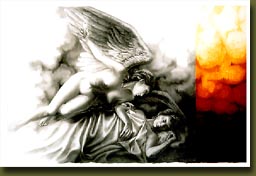 |
 |
Who is Lilith?

Lilith is an extremely controversial figure within Jewish folklore. Lilith's name is not included in the creation story of the Torah but she appears in several midrashic texts. Her symbolism, history and literature are debated among Jewish scholars, feminists and other intellectuals. There are multiple origin stories for Lilith but the most popular history told views Lilith as the first wife of Adam. According to the "first Eve" story Lilith was created by God from dust and placed to live in the garden with Adam until problems arose between Adam and Lilith when Adam tried to exercise dominance over Lilith. One story tells that Lilith refused to lay beneath Adam during sex. She believed they were created equal, both from the dust of the earth, thus she should not have to lay beneath him. After Adam disagreed, Lilith fled the Garden of Eden to gain her independence. Adam told God that Lilith had left and God sent three angels, Senoi, Sansenoi, and Sammangelof, to retrieve her. The three angels found Lilith in a cave bearing children but Lilith refused to come back to the garden. The angels told her they would kill 100 of her children every day for her disobedience. In revenge, she is said to rob children of life and is responsible for the deaths of still-born infants and crib deaths (SIDS). Male children are at risk of Lilith's wrath for 8 days after birth (until circumcision) and girls are at risk for 20 days. Although Lilith stole children's lives in the night, she agreed not to kill the children who had amulets of either of the three angels.
After the angels' departure, Lilith tried to return to the garden but upon her arrival she discovered that Adam already had another mate, Eve. Out of revenge, Lilith had sex with Adam while he was sleeping and "stole his seed." With his seed she bears 'lilium,' earth-bound demons to replace her children killed by the angels. Lilith is also said to be responsible for males' erotic dreams and night emissions. Another theory says that Lilith is impregnated, thus creating more demons by masturbation and erotic dreams.
Although the figure of Lilith is commonly found in Jewish folklore and midrash, the origin of Lilith is as a Sumerian succubus. The first Jewish story of Lilith was told in the Alphabet of ben sirah. Before the introduction of the Alphabet of ben sirah, Lilith was mostly seen as a demoness instead of the "first Eve". Due to the ambiguity of Lilith, she has been represented in multiple forms in both literature and art. Some theological scholars acknowledge Lilith as the "first Eve" while others still see her as a demoness. Historically in art, Lilith has been portrayed variously ranging from risqué versions to Lilith in the garden. To view some of these depictions click on pictures on the UPenn website on Lilith.
The open-ended nature of the Lilith symbol has allowed different groups to use her as a destructive female symbol or a symbol of female power. Many feminists see Lilith as not only the first woman but the first independent woman created. In the creation story she refuses to allow Adam to dominate her and flees the garden despite the consequences. In order to retain her freedom she must give up her children and in retaliation she steals the seed of Adam. In one account of this story, Lilith is said to "mount Adam" (click here for this version). This version of the story implies that Lilith sexually violated Adam; however, other stories portray Lilith as a demoness who kills children and takes advantage of men while they are sleeping. Jewish halakhic law forbids the spilling of a man's seed and Lilith takes advantage of this, during masturbation and erotic dreams, and uses it to replenish her own offspring.
Although Lilith is controversial some feminists have used her as a symbol of empowerment. For example, one Jewish feminist magazine is called Lilith labels itself as an "Independent Jewish Woman's Magazine." The publishers use Lilith as a title because they believe she is a symbol of independence. However, those who still think of her as a demoness could turn it around and once again label feminists as male bashers or men-haters. They see Lilith as wicked and vengeful towards men and children. With any symbol or icon used by feminists, especially within a religious context, there will be controversy and opposition. Whether or not the story of Lilith is accurate is not the main issue. The "first Eve" version of the story gives Lilith a role that many women can identify within Judaism and other religious traditions. She is an independent woman who challenges the oppressive system in which she is placed. Stealing the lives of children represents a certain madness that accompanies her solitude and exclusion. Despite Lilith's downfalls, she still remains a symbol of power simply by her survival and mysteriousness. She is open for interpretation and therefore allows women to reinterpret her symbolism and power within the tradition.